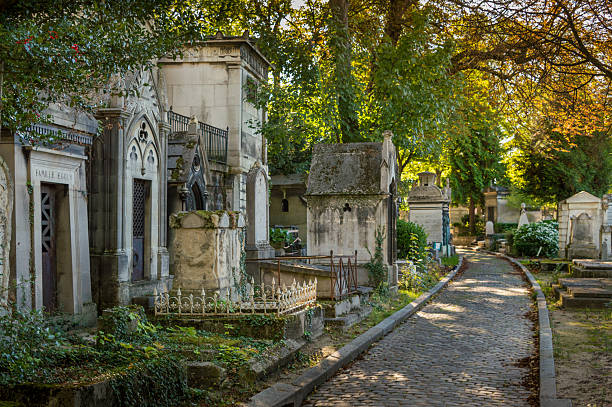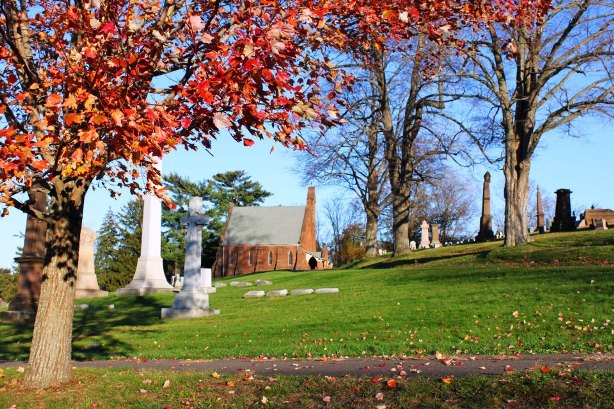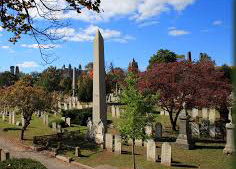At the turn of the 19th Century, Paris, France was the second largest city in Europe and growing. Inherently, as Paris grew, so did the number of deceased persons and demand for burial space. With church yards nearing capacity, a health crisis loomed over the city. In 1804, Napoleon Bonaparte adopted a solution proposed by architect Alexandre-Théodore Brongniart that transformed the design and interpretation of cemeteries for generations to come.

With winding paths and large shade trees, Père Lachaise soon became a destination for city dwellers who wished to escape the hustle and bustle of a growing metropolis. This nature-based style of cemetery, also nondenominational, beckoned all to stroll and picnic as if it were a public park. Planners, designers, and horticulturalists alike took notice. Rural and peaceful, the grounds created opportunities for recreation and relaxation in a restorative environment – nature. Fittingly, they also came to shape the public’s views on mortality from life as fleeting and tragic into more of a natural and accepting outlook. In time, the physical, mental, and social health benefits produced by these urban “parks” would gain broader recognition for their life enhancing qualities.

By the 1930’s, the rural, garden cemetery movement had taken off in the United States. In Massachusetts, approximately two decades after the opening of historic Mount Auburn Cemetery (1831), the famed author and naturalist Henry David Thoreau would state in his essay Walking “I think that I cannot preserve my health and spirits, unless I spend four hours a day at least—and it is commonly more than that—sauntering through the woods and over the hills and fields, absolutely free from all worldly engagements.” For Thoreau, immersion in nature had healing and therapeutic qualities that were essential to a healthy mind, body, and spirit. And not coincidentally, Thoreau’s final resting place is in a garden cemetery. While folks may have recognized the intrinsic value of nature during Thoreau’s time, it would be another century before medical researchers began to quantify the healing power of nature.

In 1984, Roger Ulrich, a research professor with Texas A&M University, conducted a study of patients recovering from gall bladder surgery that would come to be known as “View Through a Window”1. The study demonstrated that post operative patients who had views of nature from their recovery rooms were discharged by their doctors sooner and took less pain medication than those who did not. These findings ignited an enthusiasm for studying the healing properties of nature. The next 40 years of research would not only demonstrate the immense value of nature on human health, but it would lead to calls for equitable access to green space as a quality-of-life issue, particularly within urban areas.

Key findings associated with green space throughout this body of research2 include physical, mental, and social health benefits. Outdoor exercise activities provide a multitude of physical health benefits including the prevention of cardiovascular disease. Moreover, studies demonstrate that people tend to exercise for longer periods of time and more vigorously outdoors than indoors. Regarding mental health, immersion in nature correlates with an increase in memory and attention, and at the same time, a decrease in anxiety, depression, and stress. As for social benefits, green space encourages people to spend more time outside, which in turn fosters greater social interaction, a vital contributor to overall health and longevity. And there are far more health benefits worth touting than presented here. Simply put, the overall effect of green space on human health is astounding.
As it relates to cemeteries, the planning, care, and maintenance of natural and woody landscapes not only supports those who patron these grounds, but it renders cemeteries as vital assets in the community. Like a public park, cemeteries that embrace natural elements are valuable resources that function as green infrastructure. Communicating the health benefits of these spaces can only enhance the perception of cemeteries as an integral component of healthy communities.

With regards to the grieving process, natural settings increase positive emotions, as well as the ability to reflect on life problems – like the heartache and stress of losing a loved one. The grand effect of garden-style cemeteries is one of permanent placement and memorialization that also supports the health and well-being of the families they serve, as well as those in the community simply looking for a safe, peaceful, and healthy dose of nature.
For more information on tree health benefits, including ideas for sharing them with the public, please contact me by emailing to doak.marasco@davey.com.
To your health,
Doak Marasco

References
- https://pubmed.ncbi.nlm.nih.gov/6143402/
- https://www.fs.usda.gov/sites/default/files/fs_media/fs_document/urbannatureforhumanhealthandwellbeing_508_01_30_18.pdf
Doak Marasco is Manager of Strategic Partnerships for The Davey Tree Expert Company. He is a Board Certified Master Arborist® (ISA) and has a B.S. in Urban Forestry from The Pennsylvania State University. Mr. Marasco is dedicated to helping cemeterians find practical solutions for managing and enhancing their natural resources.
